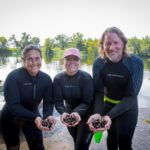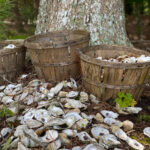Mussels: Nature’s Water Filters

Wavy-rayed Lampmussel waving around its fish lure. Photo by Rachel Mair.
A single mussel can filter up to 15 gallons of water per day, removing harmful algae, bacteria, and even metals in rivers and lakes. These natural water filters prevent pollutants, such as nitrogen, from flowing downstream and create clearer, cleaner water. Mussel beds create crucial underwater habitats for small aquatic species while serving as a food source for fish.
Unfortunately, mussels are devastatingly threatened by pollution, dams, climate change, viruses, and loss of habitat. Roughly 70 percent of the North American mussel species are threatened and more than two dozen of them have already gone extinct, making them one of the most endangered animal groups on the planet.
Virginia’s mussels aren’t looking too hot, either. Mussel populations in the Chesapeake Bay watershed are estimated to have fallen by 90 percent since European colonists first arrived in the 1600’s.
So, What’s the Plan?
For the first time in Virginia’s history, the General Assembly approved $400,000 to fund a statewide freshwater mussel restoration plan this year. The Virginia Department of Wildlife Resources will receive the funds over the next two years to hire two additional staff members and plan strategies to restore dwindling populations.
This funding can be used for restoration projects like this past summer where approximately 1,300 federally endangered James spinymussels were tagged and released into the James River—the first since the 1960’s.

More than a thousand tagged James spinymussels were planted in the James River. With luck, they’ll survive for decades. Photo by Meghan Marchetti, Department of Wildlife Resources.
Additionally, the James River Association and Chesapeake Bay Foundation recently launched two new projects to restore freshwater mussels to the James River and throughout Virginia.
Funded by the National Fish & Wildlife Foundation under the new Chesapeake WILD program, the Chesapeake Bay Foundation will create an interactive map of Virginia that highlights stretches of streams, rivers, and forest buffers with critical freshwater mussel habitat or protection areas, guiding future restoration and conservation efforts. Because work to plant forested stream buffers is increasing, this map can show where planting trees can most effectively lead to healthy streams.
To raise awareness about the rich diversity of mussels in Virginia, the project will also create realistic 3D models of mussel shells representing all the species in the Chesapeake Bay watershed, working together with the Smithsonian Institution and Florida Museum of Natural History. The scans will be open-source and available to everyone.
The James River Association will create a plan to guide future freshwater mussel restoration work throughout the James River Basin. Experts from research institutions and federal and state agencies will help set goals for mussel planting work, identifying priority areas, species, and target population sizes. The collaborative process, and the resulting plan, will serve as a model for other rivers across the state.
Protecting & Restoring Virginia’s Bivalves
See our policy recommendations in Our Common Agenda Environmental Briefing Book to help Virginia protect its bivalves.
Thank you to our Network Partners at James River Association, The Nature Conservancy, Chesapeake Bay Foundation, and Friends of the Rappahannock for providing expertise on these policy solutions.


